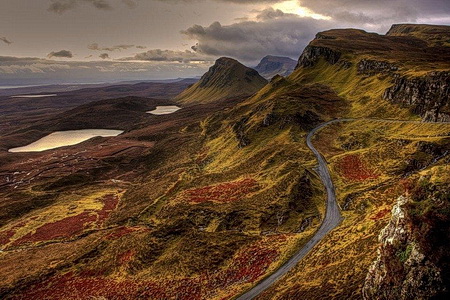What is a Maar?

Maar is a shallow depression (also known as a volcanic crater) with steep sides and is one of the most common volcanic landforms found on Earth. It is formed when the hot magma inside the surface of the Earth is ready to explode. But along the way, it comes in contact with groundwater. As a result of boiling lava colliding with water, there is a massive steam explosion and consequently, the rocks are ejected far into the air along with steam and ashes of the magma. As molten lava reacts with cool water, the resulting steam explosion creates a depression that eventually gets filled with water. The result is the creation of a landform similar to a crater. The difference is that craters are usually below the original surface of the ground.
Very often, as the rocks above the ground water are shattered and the water usually reaches the surface of the Earth resulting in a shallow lake. As the rocks land back on the surface, they form a tephra which surrounds the crater and forms steep edges.
Usually, maars are formed when there are multiple explosions at different depths. So after an initial explosion, when water finds its way up to the newly formed crater, it provides fuel for additional steam explosions.
Biggest Maar on Earth
Typically, maars range from a few hundred to a thousand feet in diameter and they are often less than 300 feet in depth. But the average width of most maars is about 1,000 feet. The size of the maar is limited because the lava does not erupt. Instead it collides with water and the reaction immediately stops. While the average size of maars is mentioned above, there are a few which are much larger than average. Let’s take a look at some of the biggest maars on the planet.
The Devil Mountain Lakes
The largest known maar on Earth is the Devil Mountain Maar Lake in the northern part of the Seward Peninsula of Alaska. It is a result of a volcanic eruption which reacted with water around 17,500 years ago. The resulting explosion affected an area of around 950 square miles. The maar which was formed as a result of this reaction is almost five miles wide and 3.7 miles deep.
The resulting tephra which was formed is several feet thick. As it moves farther away from the maar, the thickness of the tephra decreases.
The Devil Mountain Maar Lake is unique because it was formed as a result of a complex reaction between the molten lava and ground water at different depths. This complicated reaction is the reason for the unusual size of the maar.
North and South Killeak Maar
The North and South Killeak maars, also located in Alaska are two distinct maars in the same region. The South Killeak maar is considered to be around 40,000 years old. This is a huge maar which is more than three miles long is around 200 feet deep.
The maar on the Northern side is slightly older and is considered to have an age of 50,000 years. However, it is slightly smaller than the South Killeak maar. This maar measures 2.5 miles in length and is around 80 feet deep.
Whitefish Maar
The oldest, yet the smallest among the three largest maars is the Whitefish Maar, also in Alaska. It is estimated that this land mass was formed between 100,000 and 200,000 years ago. With a length of almost 2.5 miles and unidentified depth, the Whitefish maar remains one of the largest known maars on the planet.
Evidence of Maar on Mars
While maars are a significant landform on Earth, there is evidence that these landforms exist on the planet Mars as well. Scientists and researchers around the world have a special interest in the Red Planet due to its similarities with Earth. They have managed to find evidence of a similar reaction taking place between molten lava and ground water at several places. So far research indicates that the maars on Mars are relatively smaller compared to those on Earth. Also according to research, the resulting maars are due to one or two explosions resulting from a reaction between water and molten lava.
Significance of Maars on Mars
The evidence of maars on Mars is an extremely important discovery. It indicates that the reaction is taking place very close to the surface. There is evidence that the molten lava and water reacts just around 1.5 miles under the surface of the planet. This means that discovery of the materials resulting in the formation of a maar is relatively easy.
But the evidence of a Martian maars is significant because it indicates the presence of water. Since water is an essential ingredient of life and also is an ingredient of the formation of a maar, there is a promising indication that there may be the presence of water on the Red Planet.
Another reason why the discovery of Martian maars is so important is that there is evidence of fossils on Mars as well. This can play a critical role in finding out if martian life once existed on the planet.
Conclusion
There are many unique processes which are constantly taking place under the surface of the Earth but we only get to know about them if we find evidence on the land. Maars are a result of such hidden entities. The discovery of this phenomena taking place on Mars is an indication of the possibility of life on the Red Planet; something we are all eagerly waiting to find out.
